#bacillus subtilis biopesticide
Text
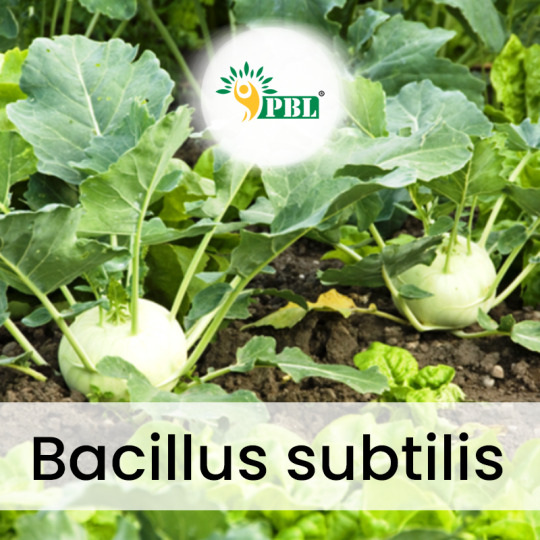
Bacillus Subtilis Biofungicide
Bacillus subtilis biofungicide is a powerhouse solution in plant protection and growth enhancement. Functioning as both a biofungicide and a Plant Growth Promoting Rhizobacteria (PGPR), it fortifies roots by deterring spore germination in plant pathogens and inhibiting their attachment. This exceptional biopesticide excels against soil-borne fungal diseases, as well as leaf and fruit infections. Bacillus Subtilis fungicide thrives in its role, fostering nutrient fixation, soil phosphorus solubilization, and siderophore production. By promoting secondary metabolites, phytohormone regulation, and stress resilience, it nurtures robust plant health, instigates vigorous growth, and primes roots for optimal vitality.
#bacillus subtilis#bacillus subtilis biofungicide#bacillus subtilis biopesticide#bacillus subtilis fungicide#bacillus subtilis manufacturers
0 notes
Text
India Agricultural Biologicals Market Will Hit Big Revenues In Future | Biggest Opportunity Of 2024
Latest added India Agricultural Biologicals Market research study by Market Research Forecast offers detailed outlook and elaborates market review till 2030. The market Study is segmented by key regions that are accelerating the marketization. At present, the market players are strategizing and overcoming challenges of current scenario; some of the key players in the study are Coromandel International Limited (India),SOM PHYTOPHARMA (INDIA) LIMITED (India),UPL Limited (India),PI Industries Ltd (India),Sumitomo Chemical Co., Ltd. (Japan),Indian Farmers Fertilizer Cooperative Limited (India),Ajay Bio-Tech (INDIA) Ltd. (India),Biotech International Ltd. (India),IPL Biologicals (India),T. Stanes and Company Limited (India)} etc.
Free Sample Report + All Related Graphs & Charts @: https://marketresearchforecast.com/report/india-agricultural-biologicals-market-1144/sample-report
The India Agricultural Biologicals Market size was valued at USD 446.26 USD Million in 2023 and is projected to reach USD 1120.78 USD Million by 2032, exhibiting a CAGR of 14.06 % during the forecast period.
The latest edition of this report you will be entitled to receive additional chapter / commentary on latest scenario, economic slowdown and COVID-19 impact on overall industry. Further it will also provide qualitative information about when industry could come back on track and what possible measures industry players are taking to deal with current situation. Each of the segment analysis table for forecast period also high % impact on growth.
This research is categorized differently considering the various aspects of this market. It also evaluates the upcoming situation by considering project pipelines of company, long term agreements to derive growth estimates. The forecast is analyzed based on the volume and revenue of this market. The tools used for analyzing the Global India Agricultural Biologicals Market research report include SWOT analysis.
September 2023: FMC India launched biological crop protection solution Entazia biofungicide in the country. The product has been formulated with Bacillus subtilis, which helps to control bacterial leaf blight in rice.,July 2023: Dhanuka Agritech Ltd., an India-based agri-input manufacturer, launched DEFEND, a new insecticide for the Indian market. The product contains Triflumezopyrim 10% SC, which provides protection against hoppers. ,June 2023: IPL Biologicals backed Unnati Agri, an agriculture supply chain and financial services startup, to focus on climate-ready products. The company invested nearly USD 3.5 million to expand its sustainable product portfolio across India.,October 2022: Chambal Fertilizers and Chemicals Limited (CFCL) partnered with The Energy and Resources Institute's (TERI) SMART Agrisolutions and launched “UTTAM SUPERRHIZA” and Mycorrhiza-based biofertilizer.,August 2022: Tosla Nutricosmetics, a Slovenia-based company, expanded and completed the construction of a new production facility aimed at increasing the production of collagen supplements. }
Influencing Trend:
Subsidizing Agricultural Machinery to Propel Market to Next Height
Market Growth Drivers:
Increasing Adoption of Precision Farming Techniques to Propel Agricultural Sprayer Demand
The Global India Agricultural Biologicals segments and Market Data Break Down are illuminated below:
Type: Biopesticides, Biostimulants, and Biofertilizers,Source: Microbial and Biochemicals,Application Method: Foliar Spray, Soil Treatment, Seed Treatment, and Others,Crop: Row Crops, Fruits & Vegetables, and Others}
Have Any Questions Regarding Global India Agricultural Biologicals Market Report, Ask Our Experts@ https://marketresearchforecast.com/report/india-agricultural-biologicals-market-1144/enquiry-before-buy The regional analysis of Global India Agricultural Biologicals Market is considered for the key regions such as Asia Pacific, North America, Europe, Latin America and Rest of the World. North America is the leading region across the world. Whereas, owing to rising no. of research activities in countries such as China, India, and Japan, Asia Pacific region is also expected to exhibit higher growth rate the forecast period 2021-2027.
Highlights of the report:
A complete backdrop analysis, which includes an assessment of the parent market
Important changes in market dynamics
Market segmentation up to the second or third level
Historical, current, and projected size of the market from the standpoint of both value and volume
Reporting and evaluation of recent industry developments
Market shares and strategies of key players
Emerging niche segments and regional markets
An objective assessment of the trajectory of the market
Recommendations to companies for strengthening their foothold in the market
Strategic Points Covered in Table of Content of Global India Agricultural Biologicals Market:
Chapter 1: Introduction, market driving force product Objective of Study and Research Scope the India Agricultural Biologicals market
Chapter 2: Exclusive Summary – the basic information of the India Agricultural Biologicals Market.
Chapter 3: Displayingthe Market Dynamics- Drivers, Trends and Challenges & Opportunities of the India Agricultural Biologicals
Chapter 4: Presenting the India Agricultural Biologicals Market Factor Analysis, Porters Five Forces, Supply/Value Chain, PESTEL analysis, Market Entropy, Patent/Trademark Analysis.
Chapter 5: Displaying the by Type, End User and Region/Country 2015-2020
Chapter 6: Evaluating the leading manufacturers of the India Agricultural Biologicals market which consists of its Competitive Landscape, Peer Group Analysis, BCG Matrix & Company Profile
Chapter 7: To evaluate the market by segments, by countries and by Manufacturers/Company with revenue share and sales by key countries in these various regions (2023-2030)
Chapter 8 & 9: Displaying the Appendix, Methodology and Data Source
Finally, India Agricultural Biologicals Market is a valuable source of guidance for individuals and companies.
Get More Information: https://marketresearchforecast.com/report/india-agricultural-biologicals-market-1144/checkout?type=corporate
Key questions answered
Who are the Leading key players and what are their Key Business plans in the Global India Agricultural Biologicals market?
What are the key concerns of the five forces analysis of the Global India Agricultural Biologicals market?
What are different prospects and threats faced by the dealers in the Global India Agricultural Biologicals market?
What are the strengths and weaknesses of the key vendors?
Definitively, this report will give you an unmistakable perspective on every single reality of the market without a need to allude to some other research report or an information source. Our report will give all of you the realities about the past, present, and eventual fate of the concerned Market.
Thanks for reading this article, we can also provide customized report as per company’s specific needs. You can also get separate chapter wise or region wise report versions including North America, Europe or Asia.
Contact US :
Craig Francis (PR & Marketing Manager)
Market Research Forecast
Unit No. 429, Parsonage Road Edison, NJ
New Jersey USA – 08837
Phone: +1 201 565 3262, +44 161 818 8166
[email protected]
0 notes
Text
Microbial Biopesticides: Controlling Xanthomonas citri in Cashew
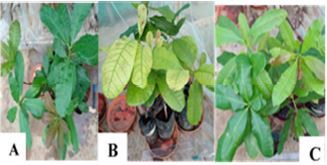
Abstract
The cashew tree (Anacardium occidentale L.) occupies an important place in the world because of its cashew nut. However, its cultivation is confronted with bacteriosis, a bacterial disease caused by Xanthomonas citri pv. Mangiferaeindicae. This disease is one of the main causes of the low yield per hectare of cashew nuts, which fluctuates between 350 and 500 kg/ha. In view of this, it is wise to find ways of controlling this disease. It is in this context the objective of this work was to produce bio-formulations based on bacteria isolated from the rhizosphere of cashew trees, in order to evaluate their effectiveness on the growth of the agent responsible for cashew bacteriosis (Xanthomonas citri pv. Mangiferaeindicae). Thus, two liquid formulations were made from Pseudomonas fluorescens and Bacillus subtilis isolated from the rhizosphere of cashew. Stability, in vitro antagonism and biocontrol tests against Xanthomonas citri pv. Mangiferaeindicae were performed. The results obtained showed an inhibition of the Xanthomonas citri pv. Mangiferaeindicae bacterium with inhibition zones of 8.13 ± 2.1 and 25.20 ± 3.9 mm in diameter respectively for the products formulated with Bacillus subtilis and Pseudomonas fluorescens. In biocontrol tests, both formulated products showed their ability to protect cashew plants against bacterial blight with reduction rates of 80.95 ± 2.3 % and 73.80 ± 5.2% for the Pseudomonas fluorescens and Bacillus subtilis formulations, respectively. These two formulations of bacterial, once tested in cashew plantations, could be used in the biological control of cashew bacterial blight in Côte d’Ivoire.
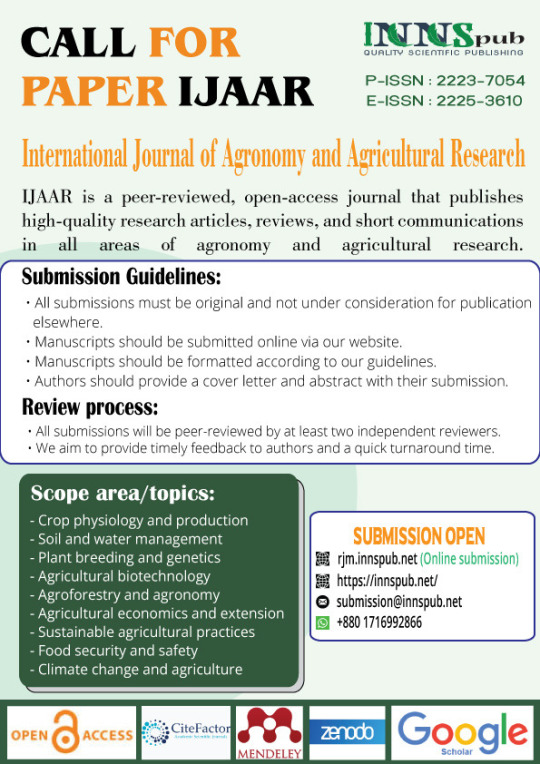
Introduction
Food security is defined as access to safe and sufficient food for all. Meeting the food demand of a rapidly growing world population is becoming a major challenge for humanity. To meet the food needs of the population, agricultural productivity will have to be increased in a sustainable manner worldwide (Kumar et al., 2012). However, insect pests and plant pathogens (fungi, bacteria or viruses) contribute to the decline in agricultural productivity, which can be as high as 70%. Indeed, plants as well as harvested and stored products are subjected to attacks by many pathogens (Popp et al., 2013). This is the case for cashew (Anacardium occidentale L.) in Côte d'Ivoire.Cashew, a crop that plays an important role in the Ivorian economy because of its cashew nut, is a particular strategic and income-generating resource for farmers in the North, South, Centre and East of the country (Soro, 2012). However, despite the economic and nutritional importance of cashew, its cultivation is subjected to several phytopathological problems that compromise the quality and quantity of cashew yield (Silué et al., 2017). Bacterial blight is a bacterial disease of cashew caused by Xanthomonas citri pv. Mangiferaeindicae. This disease manifests itself by oily angular spots on the leaves surrounded or not by a halo-chlorotic. It attacks all the vital organs of the plant with high severity (Zombre et al., 2017). In Benin, a work of Afouda et al. (2013) revealed average severities of 32.96%. This high severity of bacterial blight could lead to a decrease in cashew nut yield. Also, Soro et al. (2017) found evidence of bacterial blight in cashew orchards in Côte d'Ivoire with relative incidences of 15%. To control this disease, producers resort to the use of chemical pesticides (Camara et al., 2015).
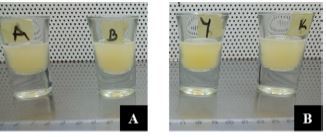
This strategy can be effective, but the repeated use of these chemicals generates harmful consequences for the environment and the health of the user. Indeed, these products favour the resistance mechanism in pathogens and the ecological imbalance due to the broad spectrum of action of most synthetic compounds. This would lead to the destruction of pests, but also of other populations in the ecosystem and can also cause serious health problems due to pesticide residues in foodstuffs (Kouassi, 2012). In order to mitigate the adverse effects of chemical pesticides, biological control agents are emerging as promising alternatives for the management of crop pathogens. Among these biological agents, microbial biopesticides (bacteria, fungi, viruses) are the most appropriate. Indeed, they offer advantages of higher selectivity and lower toxicity compared to conventional chemical pesticides (MacGregor et al., 2006). Recent studies have shown their importance in disease biocontrol (Pérez-Garcia et al., 2011). However, the formulation of microbial biopesticides is a key element in the design of control strategies for plant and crop diseases caused by plant pathogens (Nam et al., 2018).
During this decade, numerous works in greenhouse and field trials have shown the potential value of rhizosphere bacteria, including Pseudomonas fluorescens and Bacillus subtilis as biological control agents for plant pathogens (Akram, 2008). A work of Koua (2020) showed that B. subtilis strains isolated from the rhizosphere of cocoa trees in Côte d'Ivoire would be effective bioinoculants in the control of cocoa diseases in greenhouses such as swollen shoot. It would therefore be interesting to find a stable bacterial biopesticide formulation suitable for the control of bacterial diseases of cashew trees and thus find a sustainable solution to the problem posed by synthetic products in Côte d'Ivoire. The general objective of this work is to evaluate the efficacy of a formulation of bacterial biocontrol agents based on bacteria (P. fluorescens and Bacillus subtilis) isolated from the rhizosphere of cashew trees against Xanthomonas citri pv. Mangiferaeindicae.
Source : Microbial Biopesticides: Controlling Xanthomonas citri in Cashew | InformativeBD
1 note
·
View note
Text
Bacillus subtilis: Nature's Ally for Thriving Gardens with Peptech
Explore the versatile characteristics of Bacillus subtilis, a Gram-positive, rod-shaped bacterium naturally found in soil. With the ability to form endospores, it thrives in adverse conditions. This bacterium has diverse applications, serving as a biofertilizer, biopesticide, and plant growth-promoting rhizobacterium in agriculture. Its role as a biocontrol agent against plant diseases, contributions to bioremediation, and potential probiotic use highlight its significance in various fields. Peptech offers premium solutions enriched with Bacillus subtilis, enhancing nutrient availability and promoting robust plant growth. Nurture your garden with the excellence of Bacillus subtilis, where nature meets Peptech’s innovation!
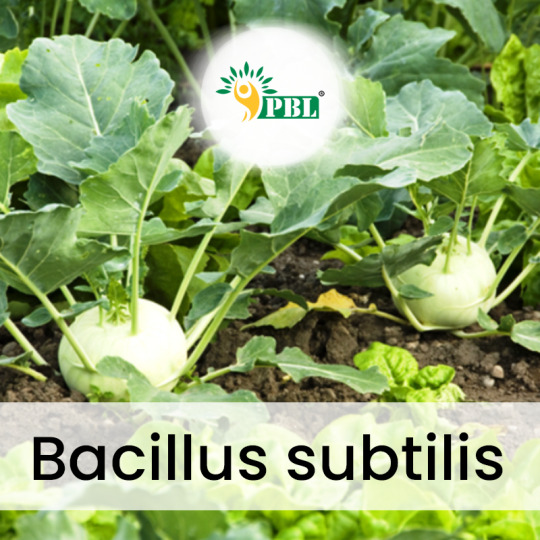
0 notes
Text
Bacillus Subtilis Fungicide
A Potent bio fungicide and Plant Growth Promoting Rhizobacteria (PGPR) .
Safeguards plants by forming a protective shield on roots, hindering spore germination in plant pathogens, and outcompeting soil microbes.
0 notes
Photo
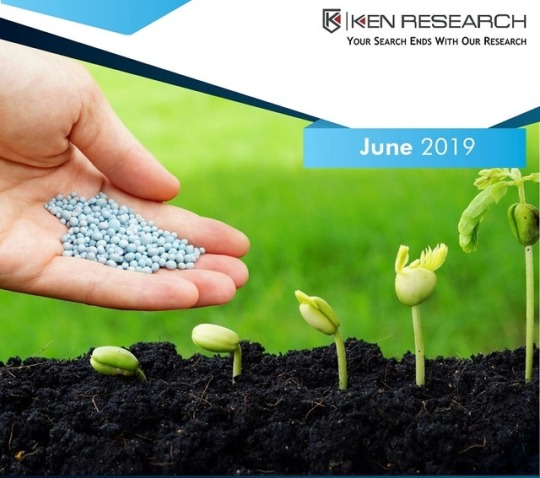
India Biopesticides Market Research Report to 2024: Ken Research How India Biopesticides Market is positioned? Indian Biopesticides Market is a house to more than 500 biopesticides that are duly registered by the Central Insecticides Board (CIB), but quality control is a major problem in most of these products.
#Ampelomyces Quisqualis Revenue India#Bacillus Subtilis Revenue India#Bio-Pesticide Investment Plant India#Biofungicides Future India#Bioinsecticide Sales India#Biopesticide Production India#Biopesticides Import India#Biopesticides Market in India#Biopesticides Sales India#Biopesticides Study India#BT pesticides Market India#Development Biopesticide India#Eco Friendly Pesticide Market India#Export Azadirachtin India#Fusarium Proliferatum Sales India#Global Biopesticide Market#India Biochemical Pesticides Market#India Biofungicides Market#India Bioherbicides Market#India Bioinsecticides Market#India Biopesticides Industry#India Biopesticides Market#India Biopesticides Market Research Report#India Botantical Biopesticide Market#India Microbial Biopesticide Market#India Neem Based Pesticides Market#Indigenious Biopesticides Sales India#Metarhizium anisopliae Revenue India#Organized Biopesticide Market#Paecilomyces lilacinus Production India
0 notes
Text
Bacterial Biopesticides Market: Regional Industry Segmentation, Analysis by Production, Consumption, Revenue and Growth Rate by 2025
United States [2021]: - Global
Bacterial Biopesticides Market
an intelligence report with meticulous efforts undertaken to study the right and valuable information. New sellers from the market are facing strong rivalry from established international vendors as they fight with technological inventions, reliability, and quality problems. Regional assessment of the global Bacterial Biopesticides market unlocks a large number of untapped opportunities in regional and domestic market places bringing into focus the most important industry trends, market size, market share estimates, and sales volume that assist the industry to surmise the strategies to increase Return On Investment [ROI]. With the study of competitor analysis conducted in this and global Bacterial Biopesticides Market report, the industry can get fluency of the strategies of key players in the market that includes new product launches, expansions, agreements, joint ventures, partnerships, and acquisitions.
The report concludes with the profiles of major players in the Bacterial Biopesticides market are: Bayer,Valent BioSciences,Dow,Koppert,W.Neudorff,Isagro,Marrone Bio Innovations,Certis Usa,Camson Biotechnologies,BASF
The main players in the Bacterial Biopesticides market are studies, and their strategies which are analyzed to arrive at current growth strategies, and potential for expansion. Additionally, the competitive landscape is because of the presence of market suppliers, numerous sales channels, and revenue options. The market document holds substantial importance when it is about explaining the market definition, classifications, applications, and engagements. Detailed company profiling enables users to evaluate company shares analysis, emerging product lines, the scope of New Product Development [NPD] in new markets, pricing strategies, innovation possibilities, and much more.
A Complete study compiled with over 100+ pages, list of tables & figures, profiling 10+ companies. Ask for FREE Sample Copy @
https://www.prudentmarkets.com/sample-request/88068/
Type Segmentation:
Bacillus Thuringiensis,Bacillus Subtilis,Pseudomonas Fluorescens,Others
Industry Segmentation:
Seed Treatment,On Farm,Post-Harvest
Bacterial Biopesticides Market
Prudent Markets provides an attractive discount on all reports. Customization of the reports as per your requirement is also offered. Get in touch with our sales team, who will guarantee you a report that suits your needs.
As the demand is driven by a shopper’s paying range and the pace of item development, the report shows the important regions that will drive growth. To comprehend market dynamics in the world mainly, the worldwide Bacterial Biopesticides market is analyzed across major global regions which gives a Customized study by a specific region or country can be provided.
• North America (the USA and Canada)
• Europe (UK, Germany, France, Italy, Spain, Scandinavia and Rest of Europe)
• Asia Pacific (Japan, China, India, Australia, Southeast Asia and Rest of Asia Pacific)
• Latin America (Brazil, Mexico and Rest of Latin America)
• Middle East & Africa (South Africa, GCC and Rest of the Middle East & Africa)
North America accounted for the largest market share owing to the increasing focus by stakeholders on research projects that consist of Bacterial Biopesticides. The market is mainly driven by advantages over other Bacterial Biopesticides due to its improved planning, high accuracy as well as greater reproducibility. However, the growth of the market is hampered by the high cost of the equipment as well as the availability of Bacterial Biopesticides in the market.
In this study, the years considered to estimate the market size of Bacterial Biopesticides Market:
History Year: 2015 – 2020
Base Year: 2020
Estimated Year: 2021
Forecast Year: 2021 – 2025
Speak To Our Analyst For A Discussion On The Above Findings, And Ask For A Discount Up To 40% On The Report @
https://www.prudentmarkets.com/discount-request/88068/
Table of Contents
Report Overview: It includes major players of the global Bacterial Biopesticides Market covered in the research study, research scope, and Market segments by type, market segments by application, years considered for the research study, and objectives of the report.
Global Growth Trends: This section focuses on industry trends where market drivers and top market trends are shed light upon. It also provides growth rates of key producers operating in the global Bacterial Biopesticides Market. Furthermore, it offers production and capacity analysis where marketing pricing trends, capacity, production, and production value of the global Bacterial Biopesticides Market are discussed.
Market Share by Manufacturers: Here, the report provides details about revenue by manufacturers, production and capacity by manufacturers, price by manufacturers, expansion plans, mergers and acquisitions, and products, market entry dates, distribution, and market areas of key manufacturers.
Market Size by Type: This section concentrates on product type segments where production value market share, price, and production market share by product type are discussed.
Market Size by Application: Besides an overview of the global Bacterial Biopesticides Market by application, it gives a study on the consumption in the global Bacterial Biopesticides Market by the application.
Production by Region: Here, the production value growth rate, production growth rate, import and export, and key players of each regional market are provided.
Consumption by Region: This section provides information on the consumption in each regional market studied in the report. The consumption is discussed on the basis of country, application, and product type.
Company Profiles: Almost all leading players of the global Bacterial Biopesticides Market are profiled in this section. The analysts have provided information about their recent developments in the global Bacterial Biopesticides Market, products, revenue, production, business, and company.
Market Forecast by Production: The production and production value forecasts included in this section are for the global Bacterial Biopesticides Market as well as for key regional markets.
Market Forecast by Consumption: The consumption and consumption value forecasts included in this section are for the global Bacterial Biopesticides Market as well as for key regional markets.
Value Chain and Sales Analysis: It deeply analyzes customers, distributors, sales channels, and the value chain of the global Bacterial Biopesticides Market.
Key Findings: This section gives a quick look at the important findings of the research study.
Free Customization on the basis of client requirements on Immediate purchase:
1- Free country-level breakdown of any 5 countries of your interest.
2- Competitive breakdown of segment revenue by market players.
Any query about Bacterial Biopesticides Industry? Well put you on the Right Path @
https://www.prudentmarkets.com/enquiry-request/88068/
Thinking One Step Ahead
In today’s competitive world you need to think one step ahead to pursue your competitors, our research offers reviews about key players, major collaborations, union & acquisitions along with trending innovation and business policies to present a better understanding to drive the business in the correct direction.
In conclusion, the Bacterial Biopesticides Market report is a genuine source for accessing the research data which is projected to exponentially grow your business. The report provides information such as economic scenarios, benefits, limits, trends, market growth rates, and figures.
To know about the global trends impacting the future of Bacterial Biopesticides market research Connect with us.
Contact Us:
Allan Carter
USA/Canada(Toll Free): 1800-601-6071
Direct Line: +91 83560 50278
Mail:
Web:
www.prudentmarkets.com
Connect with us at
LinkedIn
|
Twitter
0 notes
Text
Bacillus Subtilis Based Biofungicide For Healthy Growth Of Plants
Bacillus Subtilis Fungicide
Biofungicide actually contain a microorganism (usually a bacterium or fungus) as the active ingredient. They can control many different kinds of fungi and water molds, although each separate active ingredient controls only certain pathogens. Some also control bacterial diseases. Virtually all of the organisms used in biofungicides are naturally in soil or on plant surfaces and most are approved for use of healthy growth of plants.
Anand agrocare is a leader in the manufacturers and suppliers of bacillus subtilis Biofungicide in India. We are growing into a continuous agricultural company dedicated to the research, manufacture and marketing of ecologically organic products for agricultural growth and sustainability. Anand agro care can be used as Microbial Fungicide and Biofertilizer, increase crop growth, and stress/disease resistance.
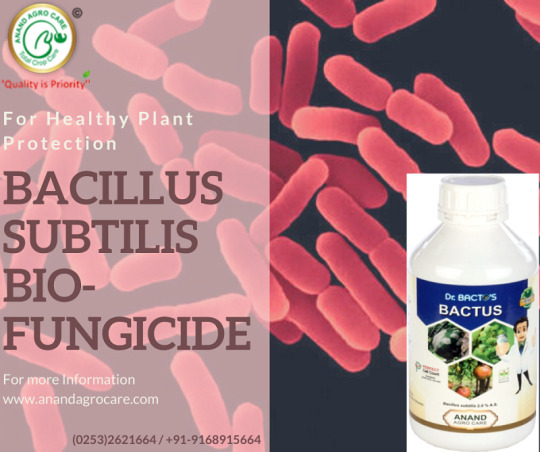
Why Important Bacillus Subtilis Fungicide?
Bacillus subtilis biofungicide is prevalent in soils and has been found in a wide range of habitats worldwide. It's in the form of a spore. Due to the following characteristics of Bacillus Subtilis Fungicide, it is widely used in agriculture.
· Eco-friendly Diseases management
· Stimulate plant growth
· Easily adaptation in various environmental conditions
Bacillus subtilis biopesticide can produce and release beneficial natural substances such as auxins, cytokinins, and gibberellins to promote plant growth. It has many applications in plant protection against phytopathogenic attacks. It can not only act as a microbial pesticide to control plant diseases, but can also be used as a biofertilizer to increase crop growth and yields.
1. Bacillus subtilis is a probiotic species commonly used in animal feed. It is added to the feed of animals in the form of spores. Bacillus subtilis can resurrect and increase its probiotic properties in the intestine of the animal, including improving the intestinal flora of the animal, enhancing the immunity of the body and providing a variety of animal enzymes required, etc.
2. Applying Bacillus subtilis to aquaculture is not toxic to aquatic animals. In aquaculture, it is used to purify water and improve the quality of the water, inhibit the excessive reproduction of harmful algae, and eliminate the silting of the bottom. It may also be used as feed additives for aquatic animals. Bacillus subtilis added to fish feed may improve the gastrointestinal function of fish, improve feed utilisation, and improve meat quality and promote growth.
Our product Dr. Bactos’s Bactus is a bio fungicide based on a selected strain of naturally-occurring antagonistic bacteria Bacillus subtilis. We are Bacillus subtilis Biofungicide manufacturer, It is an eco-friendly and highly effective biological fungicide based on Bacillus subtilis in Downey Mildew. It can work for both fungicide and plant growth, which stimulates bacteria from the rhizosphere. When applied to soil, phosphorus is symbiotically solubilized with numerous beneficial bacteria. This makes it effective in areas that have generally used phosphate-heavy fertilizers; allowing plants to absorb what is already in the soil.
Anand agro care works to provide growers with solutions that offer best in class control while reducing the chemical load on the environment and creating sustainable agriculture opportunities. We provide the company an avenue to take biological and low-chemical technology created for the agriculture industry.
Visit us:- www.anandagrocare.com/Welcome/product/bacillus-subtilis-biofungicide-manufacturer
Contact us:- 0253 262 1664 / 9168915664
#Bacillus subtilis biofungicide manufacturer#Bacillus subtilis biofungicide#Bacillus subtilis biofungicide supplier#Bacillus subtilis biofungicide in India#Bacillus subtilis biofungicide in hyderabad
0 notes
Video
youtube
Biotills #Plant #Growth #Promotion #Bacteria #plantgrowthpromotionbacteria
Agrilife
Mobile : +919885438160
www.agrilife.in
BIOTILIS TM is a biological fungicide based on a selected strain of naturally-occurring antagonistic bacteria Bacillus subtilis (NCIM 2063) BIOTILIS TM contains endospores of Bacillus subtilis . It works as both a fungicide and a plant growth promoting rhizosphere bacteria (PGPR) BIOTILIS TM is approved for use in Organic agriculture.
Applications: Bio Fungicide, Plant growth-promoting rhizosphere bacteria (PGPR) Application Types: Seed treatment , Soil application, Foliar application
Shelf Life: 6 month
#Plantgrowth-promotingrhizospherebacteria #plantgrowth #planthormones #plantgrowthregulators #plantgrowthhormones #plantgrowthregulatorsppt #growthpromotingbacteria #biotilis #biopesticides #biopesticidesmanufacturers #biopesticidesexporters #biopesticidessuppliers
0 notes
Video
youtube
Biotills #Plant #Growth #Promotion #Bacteria #plantgrowthpromotionbacteria
Agrilife
Mobile : +919885438160
www.agrilife.in
BIOTILIS TM is a biological fungicide based on a selected strain of naturally-occurring antagonistic bacteria Bacillus subtilis (NCIM 2063) BIOTILIS TM contains endospores of Bacillus subtilis . It works as both a fungicide and a plant growth promoting rhizosphere bacteria (PGPR) BIOTILIS TM is approved for use in Organic agriculture.
Applications: Bio Fungicide, Plant growth-promoting rhizosphere bacteria (PGPR) Application Types: Seed treatment , Soil application, Foliar application
Shelf Life: 6 month
#Plantgrowth-promotingrhizospherebacteria #plantgrowth #planthormones #plantgrowthregulators #plantgrowthhormones #plantgrowthregulatorsppt #growthpromotingbacteria #biotilis #biopesticides #biopesticidesmanufacturers #biopesticidesexporters #biopesticidessuppliers
0 notes
Text
Bacterial Biopesticides Market Study | Manufacturers Analysis, Size, Share and Future Prospects 2019 to 2024
“The Bacterial Biopesticides market report is a complete research on the current state of the Bacterial Biopesticides market with a focus on the regional market. This report presents the global Bacterial Biopesticides market size (value, production, and consumption), splits the breakdown (data status 2013-2018 and forecast to ‘2024’), by manufacturers, region, type, and application. This study also analyzes the market status, market share, growth rate, future trends, market drivers, opportunities and challenges, risks and entry barriers, sales channels, distributors and Porter’s Five Forces Analysis.
REPORT INCLUDES:
Data tables
An overview of the global market for Bacterial Biopesticides
Analyses of global market trends, with data from 2017, 2018, and projections of compound annual growth rates (CAGRs) through 2024
A look into background, history, development and evolution of Bacterial Biopesticides market
Detailed description about technologies, new developments and future of the Bacterial Biopesticides
Comprehensive analyses of the major players of the industry, including this Bacterial Biopesticides market research report
Get a FREE Sample PDF Report: https://www.marketgrowthinsight.com/sample/41235
The report also presents the market competitive landscape and a corresponding detailed analysis of the major vendor/key players in the market.
The players mentioned in our report
Bayer
Valent BioSciences
Dow
Koppert
W.Neudorff
Isagro
Marrone Bio Innovations
Certis Usa
Camson Biotechnologies
BASF
Global Bacterial Biopesticides Market: Product Segment Analysis
Bacillus Thuringiensis
Bacillus Subtilis
Pseudomonas Fluorescens
Others
Global Bacterial Biopesticides Market: Application Segment Analysis
Seed Treatment
On Farm
Post-Harvest
Global Bacterial Biopesticides Market: Regional Segment Analysis
USA
Europe
Japan
China
India
South East Asia
Get Discount on this Report: https://www.marketgrowthinsight.com/discount/41235
The prime objective of this Bacterial Biopesticides research report is to define the size of the different segments and the geographies as well as to forecast the trends that are likely to gain traction in the following couple of years. This market research report has been designed to incorporate both the qualitative and quantitative aspects of the industry within each of the regions.
The scope of this report centers on key market analyses, market drivers & challenges, and competitive analysis & trends. Research report examines each market and its applications, regulatory scenario, technological innovations, Bacterial Biopesticides market projections, market sizes, and shares. Moreover, the Bacterial Biopesticides market report examines the most recent trends, pipeline products and developments in the Bacterial Biopesticides market. Complete profiles of leading organizations in the market are also mentioned in this report.
In the end, It includes the methodical description of the various factors such as the market growth and a detailed information about the different company’s revenue, growth, technological developments, production, and the various other strategic developments.
REASONS TO BUY
Obtain the most up to date information available on active, planned and announced Bacterial Biopesticides in Specific Region
Identify growth segments and opportunities in the industry
Facilitate decision making on the basis of strong historic and outlook of capacity data
Assess key Bacterial Biopesticides data of your competitors.
This report is intended to enlighten manufacturers, product suppliers, providers, and suppliers. The intended audience also includes hospital system CEOs, provider groups, payer groups and investment firms working in the sector.
Purchase Bacterial Biopesticides Market Research Report: https://www.marketgrowthinsight.com/checkout/41235
Thus, the Bacterial Biopesticides Market Report serves as a valuable material for all industry competitors and individuals having a keen interest in Bacterial Biopesticides Market study.
About us :
Market Growth Insight, is a one stop solution for market research reports in various business categories. We are serving 100+ clients with 10000+ diverse industry reports and our reports are developed to simplify strategic decision making, on the basis of comprehensive and in-depth significant information, established through wide ranging analysis and latest industry trends.
Contact us :
502, Sai Radhe, Kenedy Road,
Behind Hotel Sheraton Grand,
Near Pune Station, Pune-411001,
[email protected]
+1 347 767 5477
Connect With Us : Twitter | Linkedin | Facebook | Google+
from WordPress https://ift.tt/319b6qC
via IFTTT
0 notes
Text
Factsheet 01/2018
References:
Adama (2018) Gandalf. Available at:
https://www.adama.com/uk/en/our-solutions/insecticides/gandalf.html
[Accessed 22.01.2018]
Alford, D. V. (2000) Pest and Disease Management Handbook. Bodmin: MPG Books Ltd.
Alford, D. V. (2011) Plant Pests. London: Harper Collins Publishers.
Alford, D.V. (2012) Pests of Ornamental Trees, Shrubs and Flowers: Colour Handbook. 2nd edn.
Boca Raton: Taylor and Francis Group LLC
Ali, M. A., Wieczorek, K., Kreil, D. P. and Bohlmann, H. (2014) ´The Beet Cyst Nematode Heterodera schachtii Modulates the Expression of WRKY Transcription Factors in Syncytia to Favour Its Development in Arabidopsis Roots´, Plos, Online.
Available at: http://journals.plos.org/plosone/article?id=10.1371/journal.pone.0102360
[Accessed 14.01.2018]
The Agriculture and Horticulture Development Board (2014) Encyclopaedia of
pests and natural enemies in field crops. Available at : https://cereals.ahdb.org.uk/media/524972/g62-encyclopaedia-of-pests-and-natural-enemies-in-field-crops.pdf
[Accessed 26.01.2018]
The Agriculture and Horticulture Development Board (2017) Violet Root Rot.
Available at: https://potatoes.ahdb.org.uk/media-gallery/detail/13214/2663
[Accessed 14.01.2018]
Bayer (2011) Expert Guide: Sugar Beet. Available at: https://webcache.googleusercontent.com/search?q=cache:sGwkAJ9723gJ:https://cropscience.bayer.co.uk/api/DocumentDownload/Download/%3Fid%3D100000856+&cd=11&hl=en&ct=clnk&gl=uk&client=safari
[Accessed 16.01.2018]
Bayer Cropscience Limited (2018) Escolta. Available at: https://cropscience.bayer.co.uk/our-products/fungicides/escolta/ [Accessed 23.01.2017]
Belchim (2017): Difure Pro. Available at:
http://www.belchim.co.uk/pdf/Label/DIFUREPRO_Label.pdf
[Accessed 16.01.2018]
Barnea, O., Mustata, M., Mustata, G. and Simon, E. (2005)
The parasitoid complex which control the Aphis Fabae Scop. colonies installed on different crop species and spontaneous plants. Available at:
http://www.nhm.ac.uk/resources/research-curation/projects/chalcidoids/pdf_x/barneamumu2005b.pdf
[Accessed 14.01.2018]
Betaseed (2017) Beet Cyst Nematode. Available at: http://www.betaseed.com/uk/tools/diseases_pests/details/article/beet_cyst_nematode_bcn.html
[Accessed 15.01.2018]
Buczacki, S. and Harris, K. (2014) Pest, Diseases & Disorders of Garden Plants.
4th edn. London: HarperCollins Publishers
The British Beet Research Organisation (2017) Advisory Bulletin. Available at:
https://bbro.co.uk/media/1322/bbro-advisory-bulletin-no-11.pdf
[Accessed 12.01.2018]
The British Beet Research Organisation (2017) Annual Report 2015-2016.
Available at: https://bbro.co.uk/media/1189/bbro-annual-report_final-low-res.pdf
[Accessed 12.01.2018]
Certis (2018) NEMGUard. Available at: http://www.certiseurope.co.uk/fileadmin/downloads_uk/products/Insecticides/Label_Texts/NEMGuardDE_LabelText_20170131.pdf
[Accessed 12.01.2018]
Copping, L. G. (2001) The Biopesticide Manual, 2nd edn. Norwich: The British Crop Protection Council
Daniel, U. D., Velasco, J. M. D. B., Callueng, C. J. D. and Villaalba, H.B.(2017)
´Bacillus subtilis as a biocontrol for Rhizoctonia crocorum´´, Reseachgate.
Available at: https://www.researchgate.net/publication/320615188_Bacillus_subtilis_as_a_biocontrol_for_Rhizoctonia_crocorum
[Accessed 12.01.2018]
Davies, L. J., Lilley, C. J., Knox, P. and Urwin, P. E. (2012) ´Syncytia formed by adult female Heterodera schachtii in Arabidopsis thaliana roots have a distinct cell wall molecular architecture´, New Phytologist, 196(1), pp. 238-246. doi:10.1111/j.1469-8137.2012.04238.x
DuPont (2017) UK Product Guide 2017.
Available at: http://www.dupont.co.uk/content/dam/dupont/products-and-services/crop-protection/documents/en_gb/Vydate_10G_2017_Product_guide.pdf
[22.01.2018]
Galetti, S., Burzi, P. L., Cerato, C. and Sala, E. (2017)´Trichoderma as a potential biocontrol agent for Cercospora leaf spot of sugar beet´, BioControl, 53(6), pp. 917-930.
doi:10.1007/s10526-007-9113-1
Grey, F.A., Francl, G. D., Kerr, F. D. (unknown) Available at:
https://nematode.unl.edu/extpubs/wyosbn.htm
[Accessed 23.01.2018]
Grey, A.F. and Koch, D. W. (1997) The Biology and Management of the Sugar Beet Nematode.Available at: http://www.wyomingextension.org/agpubs/pubs/B975R.pdf
[Accessed 11.01.2018]
Harveson, R. M. (2013) Cercospora Leaf Spot of Sugar Beet. Available at: http://extensionpublications.unl.edu/assets/pdf/g1753.pdf
[Accessed 15.01.2018]
Headland (2017) Corral. Available at:
http://headland-ag.co.uk/image/catalog/label/corral_5l_leaf_3aug17.pdf
[Accessed 19.01.2018]
Health and Safety Executive (2017) Pesticides Register Search. Available at:
https://secure.pesticides.gov.uk/PestReg/ProdSearch.asp
[Accessed 23.01.2018]
Horst, R. K. (1990) Wescott´s Plant Disease Handbook. 5th edn. New York: Van Nostrand Reinhold
Hurej, M. and Van der Werf, W. (1993) ´The influence of black bean aphid, Aphis fabae Scop., and its honeydew on leaf growth and dry matter production of sugar beet´, Annals of applied Biology, 122, pp. 201-214. Available at: http://edepot.wur.nl/216188
[Accessed 05.01.2017]
Iturritxa, E. and Romero, M. D. (2003) ´Chemical and Nonchemical Options for the Management of Heterodoea Schachtii in northern Spain´, Nematologia Mediterranea, 31. pp. 141-146.
Available at: https://www.researchgate.net/profile/Eugenia_Iturritxa/publication/230703669_Chemical_and_non_chemical_options_for_the_management_of_Heterodera_schachtii_in_Northern_Spain/links/586a2b9b08aebf17d3a3aeae/Chemical-and-non-chemical-options-for-the-management-of-Heterodera-schachtii-in-Northern-Spain.pdf
[Accessed 16.01.2018]
Koike, S. T., Gladders, P. and Paulus, A. O. (2007) Vegetable Diseases : A colour Handbook. 2nd. edn. London: Manson Publishing Ltd.
National Biodiversity Network (2017) Helicobasidium purpureum. Available at:
https://species.nbnatlas.org/species/BMSSYS0000007728#records
[Accessed 06.01.2018]
National Biodiversity Network (2017) Heterodea schachtii. Available at:
https://records.nbnatlas.org/occurrences/search?q=lsid:NHMSYS0000068661
[Accessed 14.01.2018]
National Biodiversity Network (2017) Aphis Fabae. Available at:
https://records.nbnatlas.org/occurrences/search?q=lsid:NHMSYS0020705203&fq=&dir=asc&sort=occurrence_date
[Accessed 14.01.2018]
Mahmoudi, M., Sahragard, A. and Sendi, J. J. (2010) ´Foraging efficiency of Lysiphlebus fabarum Marshall (Hymenoptera: Aphidiidae) parasitizing the black bean aphid, Aphis fabae Scopoli (Hemiptera: Aphididae), under laboratory conditions´, Journal of Asia-Pacific Entomology, 13(2), pp. 111-116. https://doi.org/10.1016/j.aspen.2009.11.007
Skaracis, G. N., Pavli, O. I. and Biancardi, E. (2010) ´Cercospora Leaf Spot Disease of Sugar
Beet´, Sugar Tech, 12(3), pp. 220-228. doi:10.1007/s12355-010-0055-z
Sobczak, M. and Golinowski, W. (2011) ´Cyst Nematodes and Syncytia´, in Jones, J., Gheysen. G. and Fenoli, G. (2011) Genomic and Molecular Genetics of Plant-Nematode Interactions. New York: Springer.
Steele, A (1965) The Host Range of the Sugar Beet Nematode Heterodea schachtii Schmidt.
Available at:https://www.bsdf-assbt.org/wp-content/uploads/2017/04/JSBRVol13No7P573to603TheHostRangeoftheSugarBeetNematodeHeteroderaSchachtiiSchmidt.pdf
[Accessed 17.01.2018]
Syngenta (2018) Cruiser SB. Available at:
https://www.syngenta.co.uk/sites/g/files/zhg151/f/CRUISER%20SB%20Product%20Label.pdf
[Accessed 05.01.2017]
Syngenta (2018) Armure. Available at: https://www.syngenta.co.uk/sites/g/files/zhg151/f/ARMURE%20Product%20Label.pdf?token=1511171806
[Accessed 05.01.2017]
Syngenta (2018) Priori Xtra. Available at:
https://www.syngenta.co.uk/sites/g/files/zhg151/f/PRIORI%20XTRA%20Product%20Label.pdf
[Accessed 23.02.2018]
Valder, P.G. (1958)´ The biology of Helicobasidium purpureum Pat.´, Transactions of the British Mycological Society, 14(3) pp. 283-308. doi: https://doi.org/10.1016/S0007-1536(58)80045-5
Weiland, J. and Koch, G. (2004) ´Sugarbeet leaf spot disease (Cercospora beticola Sacc.)
dagger.´, Molecular Plant Pathology, 5(39 pp. 157-166. doi:10.1111/j.1364-3703.2004.00218.x.
Figures and Plates:
Plate 1 : Helicobasidium purpupreum on Roots.
Available at: https://www.google.co.uk/url?sa=i&rct=j&q=&esrc=s&source=images&cd=&ved=0ahUKEwikqbyFp_3YAhXpKMAKHdOtC9AQjBwIBA&url=http%3A%2F%2Fephytia.inra.fr%2Ffr%2FI%2F32360%2FRhizoctonia-crocorum2&psig=AOvVaw0b2bV4gUPDcakoqsyE5aJy&ust=1517318629076524
[Accessed 09.01.2018]
Plate 2: Helicobasidium purpureum.
Available at: :http://www.entofito.com/images/bfi_thumb/sugar-beet-n9rx5a1815wqfmacmmj225cu0mbtftxldxp415v1yk.jpg
[Accessed 04.01.2018]
Plate 3: Cercospora beticola present on Beta ssp.
Available at: https://c1.staticflickr.com/1/616/23410139696_673f0d20e9_b.jpg
[Accessed 12.01.2018]
Plate 4: Cercospora beticula lesions in detail.
Available at: https://www.sesvanderhave.com/RO/sites/sesvanderhave.com.RO/files/galleries/B_3_3_Cercospora%20beticola.jpg
[Accessed 22.01.2018]
Plate 5: Heterodea schachtii appearance. Available at:
https://www.ag.ndsu.edu/publications/crops/sugar-beet-cyst-nematode/figure-2-white-lemon-s-opt.jpeg
[Accessed 12.02.2018]
Plate 6: Heterodea schachtii on fibrous roots (above). Available at:
https://www.agric.wa.gov.au/sites/gateway/files/bcn%20figure%202.jpg
[Accessed 11.01.2018]
Plate 7: Damage by Heterodea schachtii (below). Available at:
https://www.kws-uk.com/global/show_picture.asp?id=aaaaaaaaaaafcea
[Accessed 11.01.2018]
Plate 8: Aphis fabae. Available at:
http://influentialpoints.com/Gallery/Aphis_fabae_Black_Bean_aphid.htm
[Accessed 22.01.2018]
Plate 9: Colony attend by ants. Available at:
http://www.brickfieldspark.org/images/jpgs/aphidblackbean2260.jpg
[Accessed 22.01.2018]
Figure 1: Conrad (2018) All Year Guide
0 notes
Link
1 note
·
View note
Text
Bacillus Subtilis: Harnessing Nature for Crop Health
Discover the agricultural marvel of Bacillus subtilis! This beneficial bacterium serves as a natural biopesticide, safeguarding plants from diseases and promoting robust growth. Its role extends to enhancing nutrient uptake, enabling stress tolerance, and stimulating root development. Bacillus subtilis also contributes to the eco-friendly cycle by biodegrading organic matter and promoting sustainable agricultural practices. Embrace the power of nature for healthier crops and a greener future with Peptech Biosciences Ltd.

0 notes
Text
Bacillus Subtilis Biopesticide : Advancing Agriculture with Bio Fungicide and PGPR Solutions
Description:
Bacillus Subtilis Biopesticide
A Potent bio fungicide and Plant Growth Promoting Rhizobacteria (PGPR) .
Safeguards plants by forming a protective shield on roots, hindering spore germination in plant pathogens, and outcompeting soil microbes.
Benefits:
Disease Prevention:
Inhibits pathogen attachment, colonizes roots, and prevents soil-borne and foliar diseases.
Nutrient Enhancement:
Improves nitrogen fixation, solubilizes soil phosphorus, and produces siderophores for robust plant growth.
Secondary Metabolites:
Induces the production of plant secondary metabolites, regulates phytohormones, and enhances stress tolerance.
Competitive Effects:
Outcompetes pathogens through nutritional and spatial locus competition in the rhizosphere.
Antibacterial Materials:
Deploys subtilin, organic acids, and antibacterial proteins to inhibit pathogenic bacteria, enhancing disease resistance.
Target Markets:
Berries, Citrus, Banana, Grapes, Strawberries, Coffee, Cole Crops, Corn, Cucurbit Vegetables, and more.
Target Diseases:
Downey Mildew, Powdery Mildew, Leaf Blight, Double Rot, Gray Mold, Root Rot, Seedling Rot, and other diseases in various crops.
Business Impact:
Game-changer in sustainable agriculture.
Natural and effective solution for enhanced plant health and disease resistance.

PEPTECH BIOSCIENCES LTD
+91-11-71239900
909, 9th Floor, Bigjos Tower,
Netaji Subhash Place ,
New Delhi -110034
0 notes